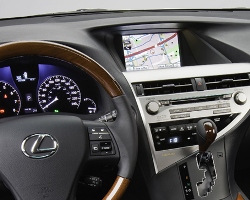If you see the driver in the next lane wildly waving his or her arms round in mid-air, it may not necessarily be cause for alarm.
It may be they are driving one of the new high tech connected cars, and they’re just giving instructions to the vehicle’s built-in gesture recognition program.
Hopefully, the driver is not inebriated: actually, if the car is truly connected, no one who fails a breathalyzer (also built in) test can even start the car!
These are just two examples of what has and what can be installed into the vehicles of tomorrow. In fact, they are built into the first connected car made with Canadian technologies already, the result of an innovative and collaborative project supported by the Ontario Centres of Excellence (OCE) and led by the Automotive Parts Manufacturers’ Association (APMA).
The connected car has as many as six separate technologies that enhance safety or improve the way drivers receive information and connect with other nearby vehicles, with the overall traffic environment, and to the larger world around them.
As many as thirteen companies participated in getting the car on the road, supported by the APMA and OCE, a government supported initiative to boost technology in the province.
Other technologies installed in the car include an early warning system that alerts drivers of approaching emergency vehicles and other urgent situations, and a platform that delivers environmental data to drivers in real-time.
They are installed in a nice 2014 Lexus RX 350, donated by Toyota Canada. Its transformation into a connected car was completed by project partners QNX Software Systems and the University of Waterloo Centre for Automotive Research (WatCAR).
Not only is the connected car seen as a major tech achievement, it is an example of good collaboration across different industry sectors.
“Building a vehicle today is the model of collaborative effort, requiring the coordination and input of suppliers across a spectrum of technologies – all of these technologies must come together in a system that delivers reliable, durable, flexible and safe transportation at an accessible price point,” explained John MacRitchie, Regional Director, Business Development Operations, Central Ontario at OCE. “Connected vehicle technologies that create a smarter car require an additional level of collaboration – going beyond mechanical and electrical connections to share information between various systems within the vehicles, between vehicles and between vehicles and external networks.”
The connected car showcases technologies from six companies supported by OCE, through a program known as the CVAV Research Program, itself a partnership of the Ministry of Transportation, the Ministry of Research and Innovation and OCE.
Such programs give Ontario and Canada a chance to demonstrate sector capabilities in the global connected car market, predicted to exceed USD $130 billion by 2019. APMA plans to showcase its connected vehicle to original equipment manufacturers (OEMs) in North America, Europe and Asia.

The connected car was developed and demonstrated as part of a multi industry partnership with private and public sector support.
In Ontario, connected car projects will encourage economic growth by creating jobs in advanced manufacturing, engineering and ICT companies, such as:
Toronto-based XYZ Interactive’s GestureSense provides low-cost, touch less control and 3D gesture recognition technology that can identify the specific x, y, and z position of an object in space, as well as its orientation with roll, pitch, yaw.
Pravala Networks’ in Kitchener has contributed an end-to-end networking platform connects the car to the cloud, providing fast, reliable and secure connectivity using 3G, Wi-Fi and Dedicated Short Range Communications (DSRC)
Waterloo’s Intelligent Mechatronic Systems’ DriveSync Connected Car Platform delivers voice-powered infotainment services as well as safety and convenience telematics services
With offices in Canada and around the world, Leggett & Platt Automotive Group’s Helios wireless charging system allows drivers to charge smartphones and other devices
Originally launched more than 30 years ago, Alcohol Countermeasure Systems is now installing its ALCOLOCK device in vehicles in order to test the breath alcohol level of drivers before allowing the engine to start
Tyco Electronics’ controlled ambient lighting system gives drivers the ability to control interior lighting levels and colours and have the lighting respond to vehicle and environment changes. The company also develops fuel cells for automobiles.
“We have the research and industry experience in computing software and hardware, in communications technologies, and in the auto sector for Ontario companies to grab a much larger share of this growing segment of the automotive industry,” MacRitchie added. “Delivering the complete, integrated systems that OEMs need from Ontario companies will help to transition our auto manufacturing sector to sustain and grow its importance in this global industry.”
Of course, if the person in the next lane is not driving a smart connected car, please be careful.
-30-




